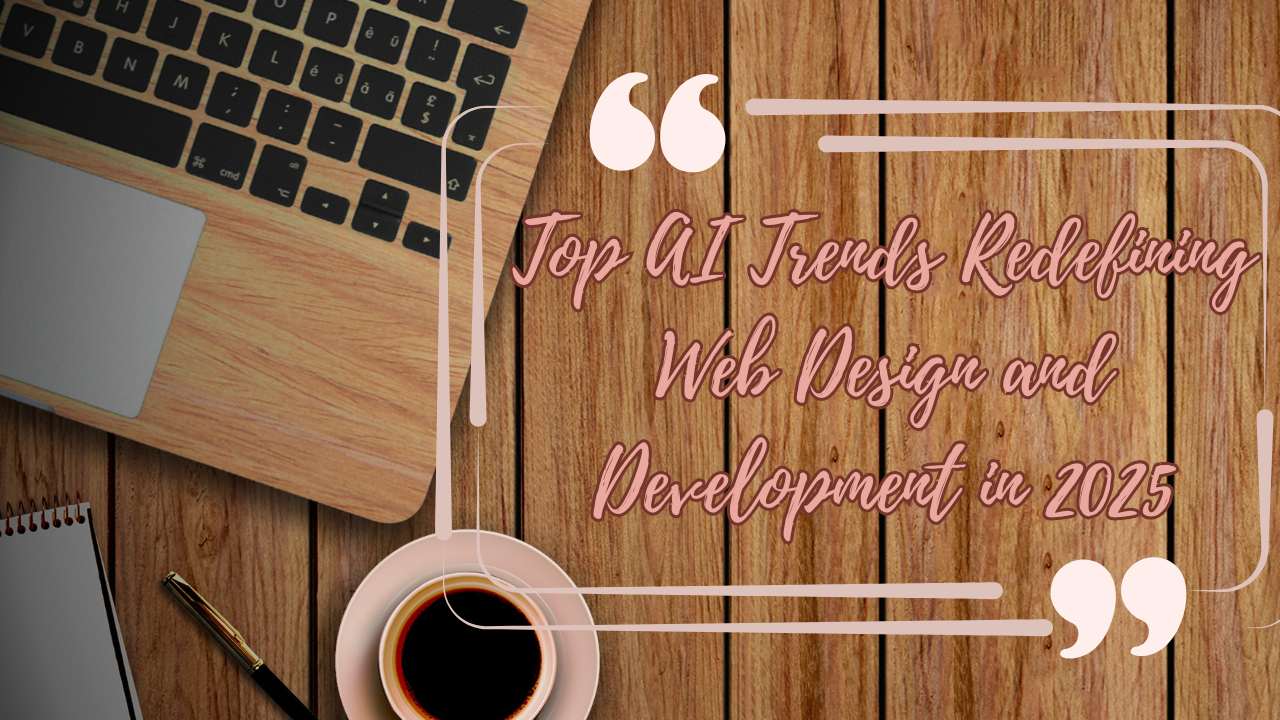Artificial Intelligence (AI) is no longer a futuristic concept — it’s now the heart of how websites are designed, developed, and managed. In 2025, AI is transforming how every web design and development company works, creating smarter and faster digital experiences than ever before. From generating layouts automatically to improving user experiences and speeding up development cycles, AI is reshaping the entire process of web design and development in ways we could only imagine a few years ago.
It’s making everything smarter, faster, and more personalized — helping businesses create websites that truly connect with their audiences.
1. AI-Powered Design Automation
One of the biggest trends in 2025 is AI-driven design automation. Tools powered by AI can now create full website layouts in minutes — something that used to take designers hours or even days.
What it means:
AI tools like Wix ADI, Framer AI, and Adobe Firefly can understand user input and generate website designs automatically. You just enter your brand name, industry, and content preferences, and the AI builds a professional-looking design instantly.
Why it matters:
- Saves time and effort
- Helps small businesses with limited budgets
- Allows designers to focus on creativity instead of repetitive layout work
AI doesn’t replace human creativity — it enhances it. Designers can now spend more time refining the design and less time doing manual tasks.
2. Personalized User Experiences with AI
In 2025, personalization isn’t just a nice feature — it’s expected. AI is now capable of analyzing user data and behavior in real time to create tailored website experiences.
How it works:
AI studies how visitors interact with a website — what they click, how long they stay, and what they ignore. Based on that, it adjusts content, product recommendations, and even color schemes to match individual preferences.
Example:
Imagine an online store that changes its homepage based on your previous purchases or browsing history. If you shop for tech gadgets, AI automatically prioritizes new product launches in that category.
Benefits:
- Higher user engagement
- Increased conversion rates
- More loyal customers
Personalization powered by AI makes users feel like the website was designed just for them.
3. AI Chatbots and Virtual Assistants
Chatbots have come a long way. In 2025, they’re no longer robotic or repetitive — they’re AI-powered virtual assistants capable of understanding context, emotions, and user intent.
What’s new:
Modern AI chatbots use natural language processing (NLP) and machine learning to provide human-like conversations. They can handle everything from product inquiries and support requests to booking appointments or even guiding users through complex processes.
Why it’s a game-changer:
- 24/7 customer support
- Improved user satisfaction
- Lower operational costs
For developers, integrating chatbots into websites is now faster and easier with platforms like ChatGPT API, Dialogflow, and Microsoft Copilot.
4. AI in UI/UX Research and Testing
Designing a great user interface (UI) and user experience (UX) has always been time-consuming. But in 2025, AI is making this process data-driven and efficient.
How AI helps:
AI tools can now:
- Analyze how users interact with different design elements
- Predict which layout will perform better
- Automate A/B testing
- Provide heatmaps to track attention and clicks
Instead of guessing what users like, designers can rely on AI insights to make smarter design decisions.
Example:
AI tools like Crazy Egg, Hotjar AI, and Figma AI Assist can simulate how users might behave on a new layout — even before the website is launched.
End result:
More intuitive designs, fewer revisions, and happier users.
5. Voice User Interfaces (VUIs) and AI Integration
With voice assistants like Alexa, Siri, and Google Assistant becoming part of daily life, voice-based interfaces are now entering web design and development in 2025.
What’s happening:
More websites are integrating voice search and navigation features, allowing users to interact hands-free. AI helps developers add natural language understanding (NLU) so users can “talk” to websites.
Benefits:
- Makes websites more accessible
- Improves convenience for mobile and smart home users
- Enhances user engagement
For example, an eCommerce website might allow users to say, “Show me red sneakers under ₹2000,” and instantly filter products accordingly.
6. AI-Powered Code Generation
Web developers are also seeing a massive shift. In 2025, AI tools like GitHub Copilot, ChatGPT, and Replit AI can write entire sections of code from simple prompts. This is transforming the way professionals approach web design and development, making it faster, smarter, and more efficient than ever.
How it helps developers:
- Reduces coding time
- Minimizes human error
- Suggests optimized and secure code
- Allows faster debugging and testing
AI doesn’t replace developers — it supports them by automating repetitive coding tasks and improving efficiency.
Example:
A developer can type:
“Create a responsive navigation bar with dropdown menus.”
and AI generates clean, production-ready code instantly.
This trend is speeding up development cycles and allowing teams to deliver projects faster than ever.
7. AI-Driven SEO and Content Optimization
AI isn’t just changing how websites look — it’s also improving how they perform. In 2025, AI-driven SEO is at the core of every successful website.
How it works:
AI tools analyze search trends, competitor data, and user intent to suggest content improvements automatically. They can optimize metadata, headings, keywords, and even generate SEO-friendly blog topics.
Tools leading the way:
- SurferSEO AI
- Frase.io
- Semrush AI Writer
Why it matters:
With AI handling SEO tasks, websites are becoming more visible, ranking faster, and maintaining consistent online performance.
8. Predictive Analytics for Smarter Design Decisions
In 2025, predictive AI helps designers and developers understand what users will want before they even ask for it.
How it works:
By analyzing historical data and user behavior patterns, AI predicts future design trends or potential usability issues. This helps businesses stay ahead of user expectations.
Example:
AI might suggest that a specific color or button placement leads to higher click-through rates based on millions of past interactions across websites.
Result:
Designers can make informed decisions backed by real data — not just instincts.
9. Generative AI for Creative Assets
AI isn’t just coding and logic — it’s creative too. In 2025, generative AI is producing visuals, graphics, icons, and even videos for web design.
Tools making it possible:
- Midjourney and DALL·E 3 for images
- Runway AI for videos
- Adobe Firefly for design elements
How it helps:
Designers can generate custom visuals instantly instead of spending hours searching for stock images. You can even create illustrations that match your brand’s tone perfectly.
This speeds up the creative process and allows smaller businesses to compete with big brands in terms of visual quality.
10. AI in Accessibility Design
Accessibility is no longer optional — it’s essential. AI in 2025 is playing a major role in making websites accessible to everyone, including users with disabilities.
How it works:
AI tools can automatically:
- Add alt text to images
- Provide voice navigation
- Adjust color contrast
- Suggest better font sizes and layouts
Example:
AI systems like AccessiBe use machine learning to detect and fix accessibility issues instantly — ensuring compliance with standards like WCAG.
Why it matters:
An accessible website not only helps more people use it but also improves brand reputation and SEO rankings.
11. Hyper-Personalized eCommerce Experiences
AI is completely transforming eCommerce design in 2025. Online stores now use AI algorithms to recommend products, change layouts, and adjust pricing based on real-time data.
How it works:
AI tracks customer behavior — from search history to purchase patterns — and delivers personalized recommendations. It can even detect when users might abandon carts and offer instant discounts to retain them.
Benefits:
- Boosted sales and conversions
- Better user satisfaction
- Stronger customer loyalty
This level of personalization makes eCommerce experiences feel one-on-one, even when serving millions of users.
12. AI for Website Maintenance and Security
Websites aren’t just built — they need to be maintained. In 2025, AI-based maintenance systems are ensuring websites stay secure and perform well around the clock.
What AI can do:
- Detect vulnerabilities and security threats
- Automatically fix broken links or slow-loading pages
- Monitor uptime and performance metrics
AI security tools also predict potential cyberattacks using behavior analysis, allowing preventive actions before damage occurs.
Example:
Platforms like Cloudflare AI Security and Sucuri AI Monitor use machine learning to identify suspicious activity instantly.
13. AI-Enhanced Motion Design and Microinteractions
In 2025, motion design — like hover effects, scroll animations, and transitions — is becoming smarter with AI. Instead of manually creating animations, designers can now use AI to generate dynamic effects automatically.
Why it’s trending:
AI analyzes where users focus their attention and adds subtle animations to guide them smoothly through the website journey.
Result:
A more engaging and interactive experience without slowing down performance.
14. Low-Code and No-Code AI Platforms
Not everyone can code — and in 2025, that’s perfectly fine. AI-powered no-code and low-code platforms like Webflow AI, Framer, and Durable allow users to design websites using simple text prompts or drag-and-drop interfaces.
Benefits:
- Businesses can launch websites faster
- Reduces dependency on large tech teams
- Makes web creation accessible to everyone
These platforms combine AI design automation with intuitive controls — giving anyone the power to build a professional website.
15. Ethical AI and Data Privacy in Web Design
As AI becomes more powerful, concerns about data privacy and ethical usage are growing too. In 2025, ethical AI practices are becoming a core part of web development.
Focus areas:
- Transparent data collection policies
- Fair and unbiased AI algorithms
- User consent for personalization
Developers are now focusing on creating trustworthy AI experiences, ensuring that automation never crosses privacy boundaries.
The Future Ahead: Human + AI Collaboration
While AI continues to reshape web design and development, it’s important to remember that humans are still at the center of creativity. AI can generate ideas, write code, and analyze data, but the human touch — empathy, emotion, and storytelling — remains irreplaceable.
The future isn’t about AI taking over; it’s about AI and humans working together to create faster, smarter, and more meaningful digital experiences.
Final Thoughts
The AI revolution in 2025 is not just about automation — it’s about transformation. Every trend we’ve explored, from generative design to AI-driven SEO, is pushing the boundaries of what’s possible in Website Design and Development Services and how businesses create digital experiences that truly stand out.
For businesses, this means more efficient processes, better-performing websites, and happier users.
For designers and developers, it’s a chance to innovate like never before.
If you’re building or redesigning your website in 2025, embracing these AI trends within your web design and development services strategy is no longer optional — it’s essential. Because in the new digital era, AI isn’t just shaping websites — it’s shaping the future of the web itself.





